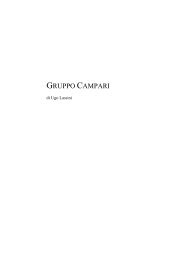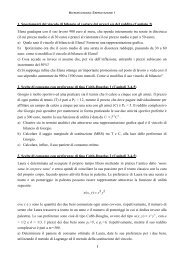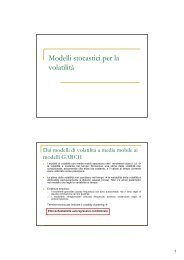Teoria della selezione del portafoglio e modelli di equilibrio del ...
Teoria della selezione del portafoglio e modelli di equilibrio del ...
Teoria della selezione del portafoglio e modelli di equilibrio del ...
You also want an ePaper? Increase the reach of your titles
YUMPU automatically turns print PDFs into web optimized ePapers that Google loves.
Tracking Error (Volatility)<br />
In<strong>di</strong>ca la variabilità <strong>del</strong>le <strong>di</strong>fferenze <strong>di</strong> ren<strong>di</strong>mento tra l’asset considerato e il benchmark.<br />
Fornisce in<strong>di</strong>cazioni sulla rischiosità che si sopporta investendo nel fondo anziché detenere<br />
<strong>di</strong>rettamente il benchmark. Quin<strong>di</strong>, in<strong>di</strong>ca quanto rischio corre il gestore per avere un<br />
determinato <strong>di</strong>fferenziale <strong>di</strong> ren<strong>di</strong>mento. Da tale analisi possiamo valutare se un gestore<br />
adotta una strategia attiva o passiva.<br />
R i = Ren<strong>di</strong>mento periodo i<br />
RD i = Ren<strong>di</strong>mento Benchmark periodo i<br />
Tracking Error Volatility =<br />
N<br />
∑<br />
I = 1<br />
( R − RD )<br />
i<br />
N −1<br />
i<br />
2<br />
133<br />
=TEV<br />
Dato annualizzato = Daily Tracking Error* 252 = TEVa<br />
VaR (Value at Risk)<br />
Il VaR è una stima, con un adeguato intervallo <strong>di</strong> confidenza, <strong>del</strong>le massime per<strong>di</strong>te <strong>di</strong> un<br />
determinato <strong>portafoglio</strong>, in un determinato intervallo <strong>di</strong> tempo.<br />
σ R = Standard Deviation giornaliera<br />
α = grado <strong>di</strong> confidenza<br />
p = intervallo <strong>di</strong> tempo<br />
c = valore associato nella tavola <strong>di</strong> <strong>di</strong>stribuzione, al grado <strong>di</strong> confidenza scelto (α)<br />
VAR = c* σ R * p<br />
Misure <strong>di</strong> Rischio/Ren<strong>di</strong>mento<br />
In<strong>di</strong>ce <strong>di</strong> Sharpe<br />
E’ la più utilizzata misura <strong>di</strong> Risk Adjusted Performance, cioè misure che considerano<br />
congiuntamente rischio e ren<strong>di</strong>mento. Rappresenta una misura <strong>del</strong> premio al rischio<br />
calcolato su basi unitarie, cioè su ogni unità <strong>di</strong> rischio.<br />
RG a = Ren<strong>di</strong>mento me<strong>di</strong>o geometrico annualizzato<br />
N = Numero dei perio<strong>di</strong><br />
σ = Standard Deviation annualizzata<br />
a<br />
R<br />
RRF a = Ren<strong>di</strong>mento annuo <strong>del</strong>l’attività “Risk Free” (Euribor a 3 mesi )
















